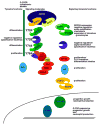Granulocyte colony-stimulating factor: molecular mechanisms of action during steady state and 'emergency' hematopoiesis
- PMID: 18400509
- PMCID: PMC2852428
- DOI: 10.1016/j.cyto.2008.03.002
Granulocyte colony-stimulating factor: molecular mechanisms of action during steady state and 'emergency' hematopoiesis
Abstract
Neutrophils are phagocytes whose principal function is to maintain anti-bacterial immunity. Neutrophils ingest and kill invading bacteria, releasing cytotoxic, chemotactic and inflammatory mediators at sites of infection. This serves to control the immediate host immune response and attract other cells, such as macrophages and dendritic cells, which are important for establishing long-term adaptive immunity. Neutrophils thus contribute to both the initiation and the maintenance of inflammation at sites of infection. Aberrant neutrophil activity is deleterious; suppressed responses can cause extreme susceptibility to infection while overactivation can lead to excessive inflammation and tissue damage. This review will focus on neutrophil regulation by granulocyte colony-stimulating factor (G-CSF), the principal cytokine controlling neutrophil development and function. The review will emphasize the molecular aspects of G-CSF-driven granulopoiesis in steady state (healthy) conditions and during demand-driven or 'emergency' conditions elicited by infection or clinical administration of G-CSF. Understanding the molecular control of granulopoiesis will aid in the development of new approaches designed to treat disorders of neutrophil production and function.
Figures



Similar articles
-
STAT3 governs distinct pathways in emergency granulopoiesis and mature neutrophils.Blood. 2006 Dec 1;108(12):3682-90. doi: 10.1182/blood-2006-02-003012. Epub 2006 Aug 3. Blood. 2006. PMID: 16888100 Free PMC article.
-
Mice lacking granulocyte colony-stimulating factor have chronic neutropenia, granulocyte and macrophage progenitor cell deficiency, and impaired neutrophil mobilization.Blood. 1994 Sep 15;84(6):1737-46. Blood. 1994. PMID: 7521686
-
Regulation of myeloid development and function by colony stimulating factors.Dev Comp Immunol. 2004 May 3;28(5):509-54. doi: 10.1016/j.dci.2003.09.010. Dev Comp Immunol. 2004. PMID: 15062647 Review.
-
Endothelial cells translate pathogen signals into G-CSF-driven emergency granulopoiesis.Blood. 2014 Aug 28;124(9):1393-403. doi: 10.1182/blood-2014-04-570762. Epub 2014 Jul 2. Blood. 2014. PMID: 24990886 Free PMC article.
-
Granulocyte-macrophage colony-stimulating factor (GM-CSF) and granulocyte colony-stimulating factor (G-CSF): receptor biology, signal transduction, and neutrophil activation.Blood Rev. 1992 Mar;6(1):43-57. doi: 10.1016/0268-960x(92)90007-d. Blood Rev. 1992. PMID: 1375123 Review.
Cited by
-
Relevance of Interferon Regulatory Factor-8 Expression in Myeloid-Tumor Interactions.J Interferon Cytokine Res. 2016 Jul;36(7):442-53. doi: 10.1089/jir.2015.0174. J Interferon Cytokine Res. 2016. PMID: 27379866 Free PMC article. Review.
-
Determining macrophage versus neutrophil contributions to innate immunity using larval zebrafish.Dis Model Mech. 2020 Jan 9;13(1):dmm041889. doi: 10.1242/dmm.041889. Dis Model Mech. 2020. PMID: 31932292 Free PMC article. Review.
-
The Ontogeny of a Neutrophil: Mechanisms of Granulopoiesis and Homeostasis.Microbiol Mol Biol Rev. 2018 Feb 7;82(1):e00057-17. doi: 10.1128/MMBR.00057-17. Print 2018 Jun. Microbiol Mol Biol Rev. 2018. PMID: 29436479 Free PMC article. Review.
-
Myeloid-derived suppressor cells in sepsis.Biomed Res Int. 2014;2014:598654. doi: 10.1155/2014/598654. Epub 2014 Jun 3. Biomed Res Int. 2014. PMID: 24995313 Free PMC article. Review.
-
Dietary supplementation of a Saccharomyces cerevisiae fermentation product attenuates exercise-induced stress markers in young horses.J Anim Sci. 2021 Aug 1;99(8):skab199. doi: 10.1093/jas/skab199. J Anim Sci. 2021. PMID: 34181712 Free PMC article.
References
-
- Huising MO, Kruiswijk CP, Flik G. Phylogeny and evolution of class-I helical cytokines. J Endocrinol. 2006;189:1–25. - PubMed
-
- Lutfalla G, Roest Crollius H, Stange-Thomann N, Jaillon O, Mogensen K, Monneron D. Comparative genomic analysis reveals independent expansion of a lineage-specific gene family in vertebrates: the class II cytokine receptors and their ligands in mammals and fish. BMC Genomics. 2003;4:29. - PMC - PubMed
-
- Lieschke GJ, Grail D, Hodgson G, Metcalf D, Stanley E, Cheers C, Fowler KJ, Basu S, Zhan YF, Dunn AR. Mice lacking granulocyte colony-stimulating factor have chronic neutropenia, granulocyte and macrophage progenitor cell deficiency, and impaired neutrophil mobilization. Blood. 1994;84:1737–46. - PubMed
-
- Zeidler C, Schwinzer B, Welte K. Congenital neutropenias. Rev Clin Exp Hematol. 2003;7:72–83. - PubMed
Publication types
MeSH terms
Substances
Grants and funding
LinkOut - more resources
Full Text Sources
Other Literature Sources
Miscellaneous

